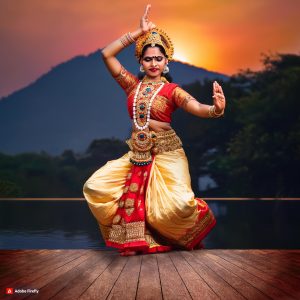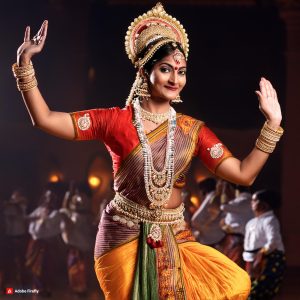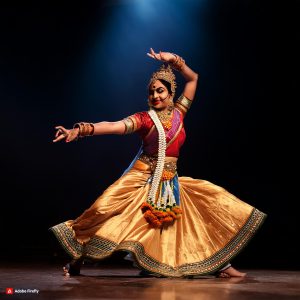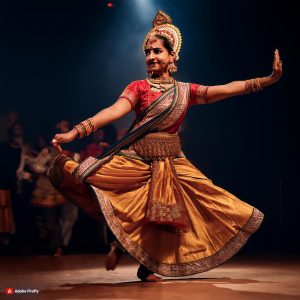Classical Dance of India: India’s classical dance forms are a beautiful manifestation of the country’s rich cultural diversity, spirituality, and history. Each dance form, whether it be Bharatanatyam, Kathak, Odissi, or any other, tells a story of devotion, mythology, and emotion, all while showcasing unparalleled artistry. These dance forms continue to be cherished, practiced, and revered across the world, preserving India’s vibrant cultural heritage for future generations.
Whether you’re a dance enthusiast or someone looking to explore India’s cultural treasures, the classical dances of India offer a mesmerizing journey into the soul of the nation.
1. Bharatanatyam (भरतनाट्यम)

Origin: Tamil Nadu
Bharatanatyam is one of the oldest and most popular classical dance forms of India, known for its fixed upper torso, bent legs, and intricate footwork. It is a highly expressive dance that combines bhava (emotion), raga (melody), tala (rhythm), and natya (drama) to narrate mythological and spiritual stories. Originally performed in temples, it has evolved into a highly respected and sophisticated art form.
Key Elements:
- Mudras (hand gestures) to convey emotions
- Abhinaya (facial expressions)
- Dynamic footwork and rhythmic patterns
2. Kathak (कथक)

Origin: Uttar Pradesh
Kathak derives its name from the Sanskrit word Katha, meaning story. It is a storytelling dance that originated in the courts of North India, where Kathakars or storytellers would narrate stories from epics like the Mahabharata and Ramayana. This dance form is characterized by intricate footwork, graceful movements, fast spins, and the use of ghungroos (ankle bells).
Key Elements:
- Tatkaar (fast rhythmic footwork)
- Pirouettes or fast spins
- Expressive storytelling through dance
3. Kathakali (कथकली)

Origin: Kerala
Kathakali is a highly stylized classical dance-drama that combines intricate costumes, elaborate makeup, and dramatic expressions. Known for its larger-than-life characters, Kathakali performances typically depict stories from Hindu epics like the Mahabharata and Ramayana. Dancers wear elaborate facial makeup, masks, and colorful costumes, creating a visually striking performance.
Key Elements:
- Mudras (hand gestures) and facial expressions
- Bright, colorful costumes and elaborate makeup
- A slow yet powerful rhythm
4. Kuchipudi (कुचिपुड़ी)

Origin: Andhra Pradesh
Kuchipudi is a classical dance form that combines dance and drama, rooted in the teachings of Natyashastra. Traditionally, it was performed by male Brahmins as a form of spiritual expression, but today, it is widely performed by both men and women. Kuchipudi performances often begin with rituals and incorporate both pure dance and acting to narrate stories from Indian mythology.
Key Elements:
- Intricate footwork and graceful movements
- Expressive storytelling through facial expressions
- Combines dance, music, and drama
5. Odissi (ओडिसी)

Origin: Odisha
Odissi is one of the oldest surviving classical dance forms, distinguished by its fluid, graceful movements and sculpturesque poses. Originally performed in temples, Odissi is deeply spiritual and devotional, paying homage to Lord Jagannath and other Hindu deities. The dance is known for its graceful postures, rhythmic movements, and abhinaya (expressive gestures).
Key Elements:
- Chauka (square posture) and Tribhangi (three-body bends)
- Smooth, flowing movements and gestures
- Deeply rooted in spiritual devotion
6. Manipuri (मणिपुरी)

Origin: Manipur
Manipuri is a graceful dance form that is deeply linked to the religious and spiritual life of Manipur. The dance is often performed as part of Ras Leela, depicting episodes from the life of Lord Krishna. Unlike other Indian classical dances, Manipuri is characterized by delicate, fluid movements and gentle, floating steps, with less emphasis on footwork and more on facial expressions.
Key Elements:
- Circular, graceful movements
- Focus on Bhakti (devotion) to Lord Krishna
- Ethereal, floating dance steps
7. Mohiniyattam (मोहिनीअट्टम)

Origin: Kerala
Mohiniyattam is a classical dance form associated with feminine grace and beauty. The name Mohiniyattam comes from Mohini, the female avatar of Lord Vishnu. This dance form is known for its gentle, swaying movements and expressions of Lasya (beauty and grace). It narrates stories through graceful movements, subtle expressions, and a soft rhythm.
Key Elements:
- Graceful swaying movements
- Gentle expressions and storytelling
- Predominantly feminine dance style
8. Sattriya (सत्रिया)

Origin: Assam
Sattriya is a relatively lesser-known but significant classical dance form that originated in the Sattras (monasteries) of Assam. Created by the Vaishnavite saint Srimanta Sankardev, it combines dance, drama, and music to depict devotional themes, particularly stories from the Bhagavata Purana and Ramayana. Traditionally performed by monks, Sattriya has now become a widely appreciated classical dance form.
Key Elements:
- Bhakti (devotion) and religious themes
- Delicate footwork and controlled movements
- Combines dance and drama
| Download Pdf | Click Here |
| Download photo | Click Here |
| Home Page | Click Here |
